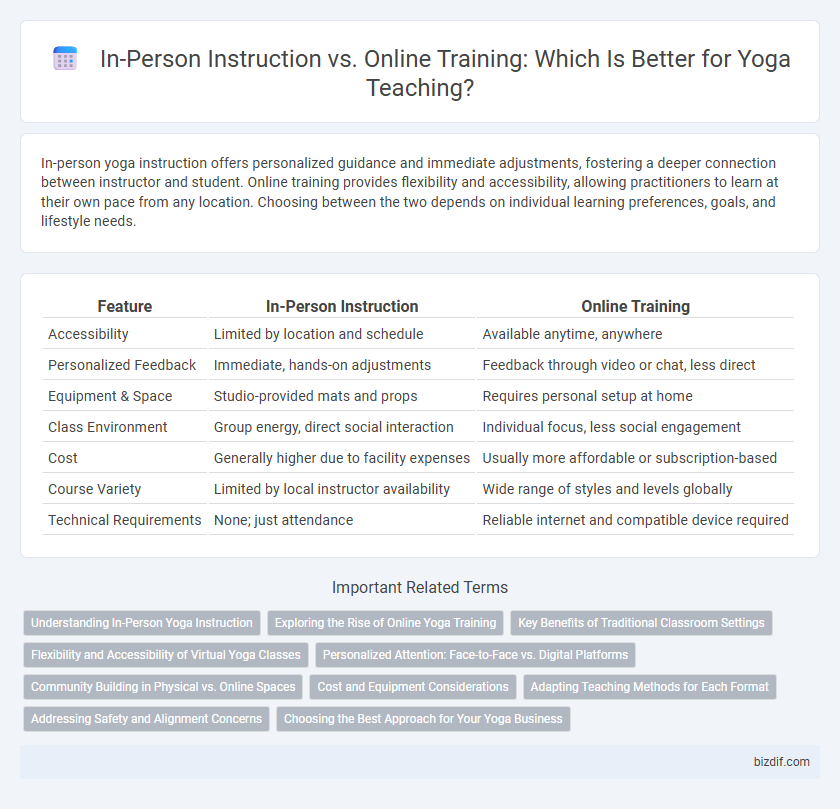In-person yoga instruction offers personalized guidance and immediate adjustments, fostering a deeper connection between instructor and student. Online training provides flexibility and accessibility, allowing practitioners to learn at their own pace from any location. Choosing between the two depends on individual learning preferences, goals, and lifestyle needs.
Table of Comparison
| Feature | In-Person Instruction | Online Training |
|---|---|---|
| Accessibility | Limited by location and schedule | Available anytime, anywhere |
| Personalized Feedback | Immediate, hands-on adjustments | Feedback through video or chat, less direct |
| Equipment & Space | Studio-provided mats and props | Requires personal setup at home |
| Class Environment | Group energy, direct social interaction | Individual focus, less social engagement |
| Cost | Generally higher due to facility expenses | Usually more affordable or subscription-based |
| Course Variety | Limited by local instructor availability | Wide range of styles and levels globally |
| Technical Requirements | None; just attendance | Reliable internet and compatible device required |
Understanding In-Person Yoga Instruction
In-person yoga instruction offers personalized feedback and hands-on adjustments that enhance alignment and posture, fostering a deeper mind-body connection. The immediate presence of a qualified instructor enables participants to receive tailored guidance, reducing the risk of injury and improving technique. This direct interaction cultivates a supportive community environment that enriches the overall practice experience.
Exploring the Rise of Online Yoga Training
Online yoga training has surged in popularity due to its accessibility, flexible scheduling, and diverse class offerings catering to various skill levels and styles. Advanced streaming technology and interactive platforms enable real-time feedback, closely replicating the in-person experience while facilitating global instructor-student connections. This digital shift allows practitioners to maintain consistent practice despite geographical or time constraints, highlighting the transformative impact of virtual environments on traditional yoga instruction.
Key Benefits of Traditional Classroom Settings
Traditional classroom yoga instruction offers direct, personalized guidance and immediate correction from experienced instructors, enhancing technique and safety. Face-to-face interaction fosters a supportive community atmosphere, encouraging motivation and accountability among students. Access to hands-on adjustments and real-time feedback ensures a deeper understanding of postures and alignment, leading to improved practice outcomes.
Flexibility and Accessibility of Virtual Yoga Classes
Virtual yoga classes provide unparalleled flexibility, allowing practitioners to access sessions anytime from any location, significantly reducing the constraints of commuting and scheduling conflicts. Online platforms offer a diverse range of styles and instructors, enhancing accessibility for individuals with varying skill levels and physical abilities. This digital format supports consistent practice by accommodating personalized pacing and immediate access to recorded content, fostering improved adherence and progression in yoga training.
Personalized Attention: Face-to-Face vs. Digital Platforms
In-person yoga instruction offers personalized attention through real-time adjustments, hands-on guidance, and immediate feedback tailored to individual posture and alignment. Online training platforms provide flexibility and convenience but often lack the tactile input and nuanced corrections that deepen practice and prevent injury. Personalized coaching in a face-to-face setting enhances body awareness and ensures proper technique more effectively than digital classes.
Community Building in Physical vs. Online Spaces
In-person yoga instruction fosters strong community building by creating shared physical spaces where participants engage through direct, face-to-face interaction, enhancing trust and collective energy. Online training offers broader accessibility and flexibility, leveraging virtual platforms to connect diverse practitioners globally, yet often lacks the tactile and spatial cues essential for deep communal bonds. Effective yoga programs integrate hybrid models to balance personal connection with expansive reach, optimizing community engagement across physical and digital environments.
Cost and Equipment Considerations
In-person yoga instruction typically involves higher costs due to studio fees, transportation expenses, and the need for specialized equipment like mats and blocks provided on-site. Online training often reduces expenses by eliminating travel and studio charges, allowing practitioners to use their existing home equipment or minimal inexpensive gear. Evaluating budget constraints alongside equipment availability can guide individuals in choosing between the more immersive in-person classes and the flexible, cost-effective online sessions.
Adapting Teaching Methods for Each Format
Adapting teaching methods for in-person yoga instruction involves emphasizing hands-on adjustments and real-time feedback, which enhances student alignment and safety. Online training requires clear verbal cues, detailed demonstrations, and the integration of visual aids to compensate for the lack of physical presence. Successful yoga instructors tailor their communication styles and technical tools to ensure effective engagement and personalized guidance across both formats.
Addressing Safety and Alignment Concerns
In-person yoga instruction provides immediate hands-on adjustments and real-time feedback, ensuring proper alignment and reducing the risk of injury. Online training offers convenience but requires clear verbal cues and visual demonstrations to help students self-correct safely. Prioritizing safety involves incorporating detailed alignment corrections and encouraging communication, regardless of the delivery method.
Choosing the Best Approach for Your Yoga Business
Selecting the right delivery method for your yoga business hinges on client preferences, accessibility, and engagement levels. In-person instruction fosters stronger community bonds and allows personalized adjustments, enhancing overall practice quality. Online training expands reach and offers flexible scheduling but requires robust digital tools and marketing strategies to maintain client retention.
In-person Instruction vs Online Training Infographic

 bizdif.com
bizdif.com